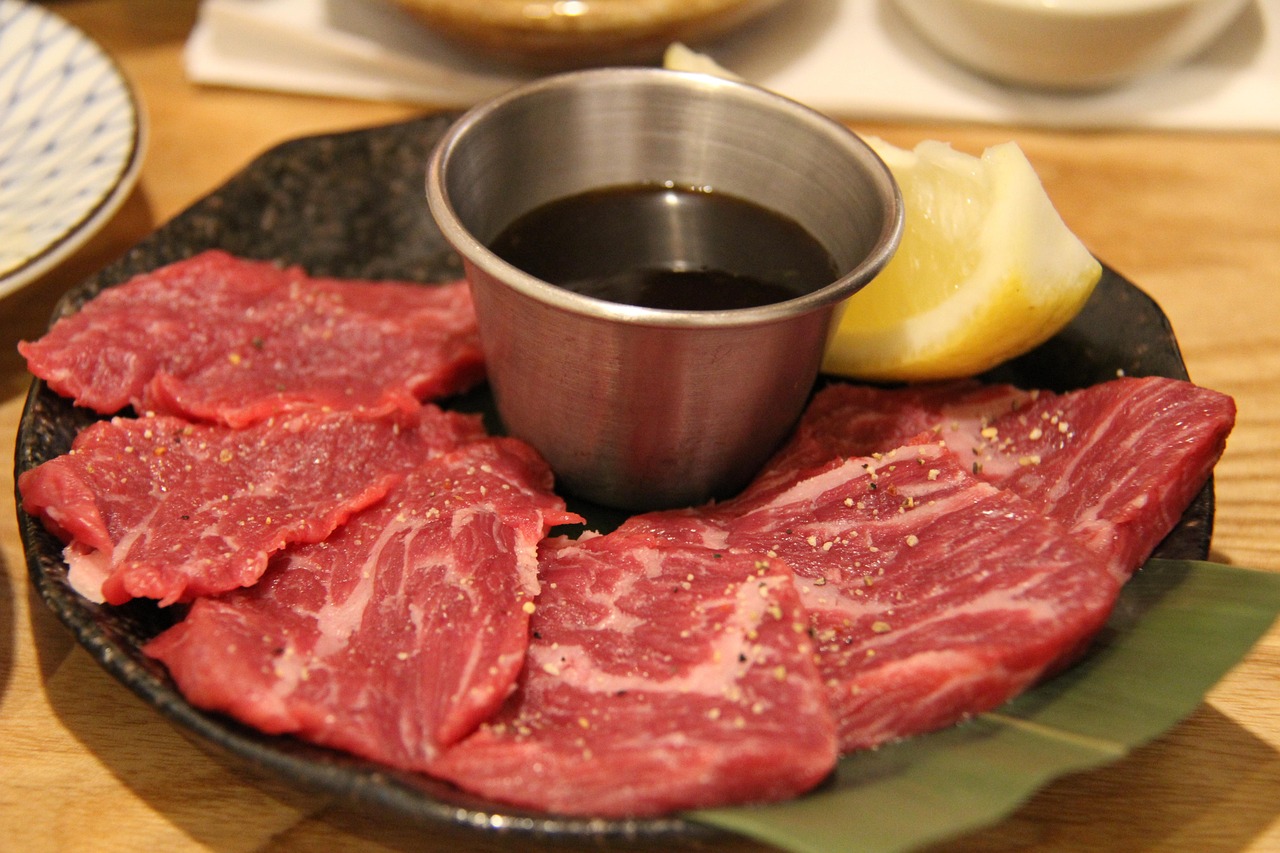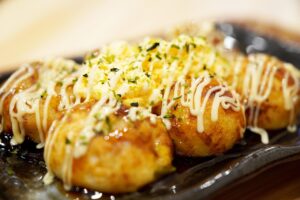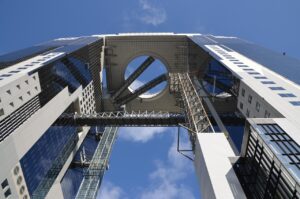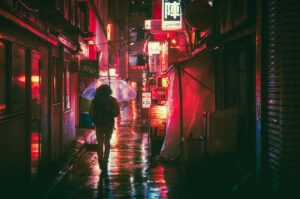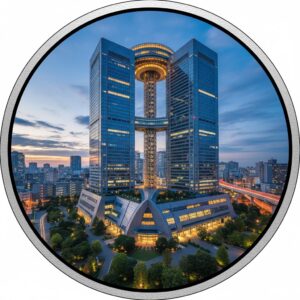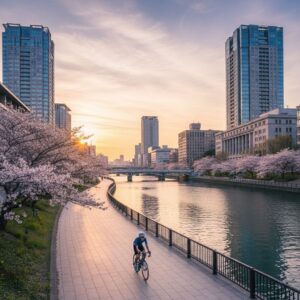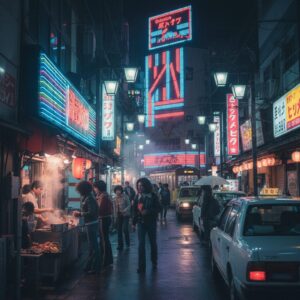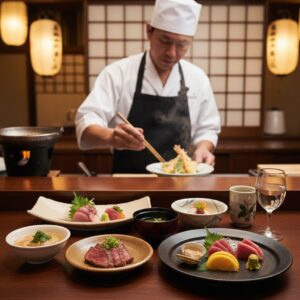The city of Osaka breathes differently at night. When the sun dips below the horizon, the concrete and steel heart of Umeda begins to pulse with a vibrant, electric energy. The endless rivers of commuters flowing through the labyrinthine Osaka Station thin out, replaced by a current of anticipation, a city stepping out for the evening. And at the center of this dazzling transformation stands the Umeda Sky Building, a colossal archway to the stars, its Floating Garden Observatory a beacon in the neon-dusted sky. This is a landscape built on ambition, a vertical world of shimmering glass and light. But Osaka’s soul isn’t just in its architecture; it’s in its flavor. It’s a city that lives to eat, a place where culinary passion is woven into the very fabric of its identity. This article is your guide to a quintessential Osaka experience, one that marries the city’s two greatest loves: breathtaking views and unforgettable food. We’re ascending into the world of fine dining Wagyu, where the most exquisite beef on the planet is served against a backdrop of a million glittering lights. It’s more than a meal; it’s a symphony for the senses, a memory etched against the skyline, a story you’ll tell long after you’ve returned home. This is where the peak of urban spectacle meets the pinnacle of Japanese gastronomy.
For a more intimate and traditional culinary adventure after your high-rise Wagyu experience, consider exploring the vibrant drinking alleys of Tenma.
The Allure of the Umeda Nightscape
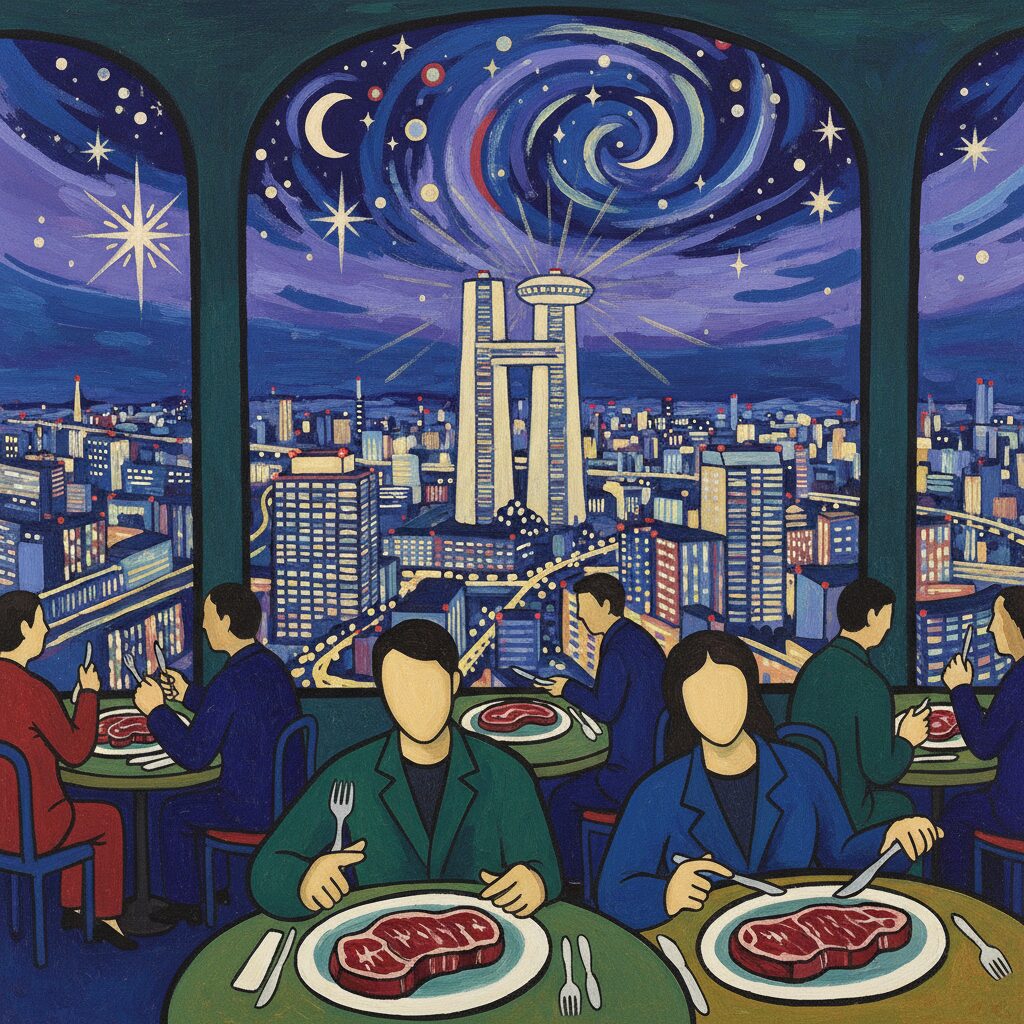
To truly appreciate the magic of dining high above Umeda, you first need to experience the energy at street level. Walking from the expansive, futuristic complex of JR Osaka Station and Grand Front Osaka toward the Sky Building is a journey in itself. You weave through broad pedestrian avenues and cross elevated walkways, the city’s hum a constant companion. The air, thick with the aromas of street food and department store perfume during the day, clears as evening cools, carrying the promise of the night ahead. As you approach, the Umeda Sky Building doesn’t merely come into view; it unveils itself. Its twin towers, linked by the iconic circular observatory, resemble something straight out of a science fiction dream, reflecting city lights on their mirrored surfaces. This is Osaka’s modern face—a monument to its post-war revival and its unyielding drive forward.
The view from the top is a living tapestry. It isn’t a still image but a dynamic, breathing entity. Rivers of white and red headlights flow along the highways, pulsing like arteries. The Yodo River carves a dark, serene path through the urban glow. Trains, like glowing caterpillars, glide silently in and out of the station far below. You can trace the outlines of distant mountains, faint shadows against the deepening indigo of the sky. The density of lights is staggering, a testament to the millions of lives unfolding across the metropolis below. Each light is a window, a story, a home. Dining here, with this panorama spread before you, turns a meal into an immersive experience. The view is not just a backdrop; it is the main character, the silent guest at your table, its grand, quiet narrative enhancing every flavor that touches your lips. It sets a tone of elegance, celebration, and the sensation of being quite literally on top of the world.
Wagyu: An Art Form Perfected Through Generations
Before we enter the quiet interiors of these sky-high restaurants, we must first honor the star of the show: Wagyu. For those who may not know, the term “Wagyu” literally means “Japanese Cow,” but it embodies a culinary world far beyond ordinary beef. It is the product of centuries of careful breeding, a national treasure safeguarded and perfected with near-spiritual dedication. This is not the beef you are familiar with from home. This is an entirely different creation.
The secret lies in the genetics and the raising process. Japanese cattle breeds, especially the Japanese Black which makes up the vast majority of Wagyu, have a unique genetic tendency to produce intense intramuscular fat. This is known as marbling, or sashi in Japanese. But this is not the thick, chewy fat you might trim off a steak. It is a delicate, intricate network of fat woven throughout the muscle itself. It is this sashi that imparts Wagyu with its signature, almost unbelievable qualities. When cooked, this fat melts at an exceptionally low temperature—you can almost feel it soften under the warmth of your fingertips. This process bastes the meat from within, creating a texture so tender and buttery it melts on the tongue with a wave of profound flavor.
That flavor is deep, complex, and lingering umami—rich and savory yet remarkably clean and never heavy. It coats your palate and evolves with every bite. The quality of this beef is so esteemed that it is graded on a rigorous scale, with A5 being the highest rank, a classification reserved for only the most perfectly marbled, finely textured, and beautifully colored cuts. To eat A5 Wagyu is to experience the Japanese pursuit of perfection, kodawari, in its most delectable form. It is a culinary art where the rancher, butcher, and chef are all artists contributing to a final masterpiece. In Osaka, a city devoted to the best of the best, serving anything less than sublime Wagyu in a prime setting would be unthinkable. Here, it is treated with the reverence it commands, prepared by chefs whose entire careers have been dedicated to mastering its delicate nature.
Where Culinary Heights Meet Urban Heights: Finding Your Perfect Table
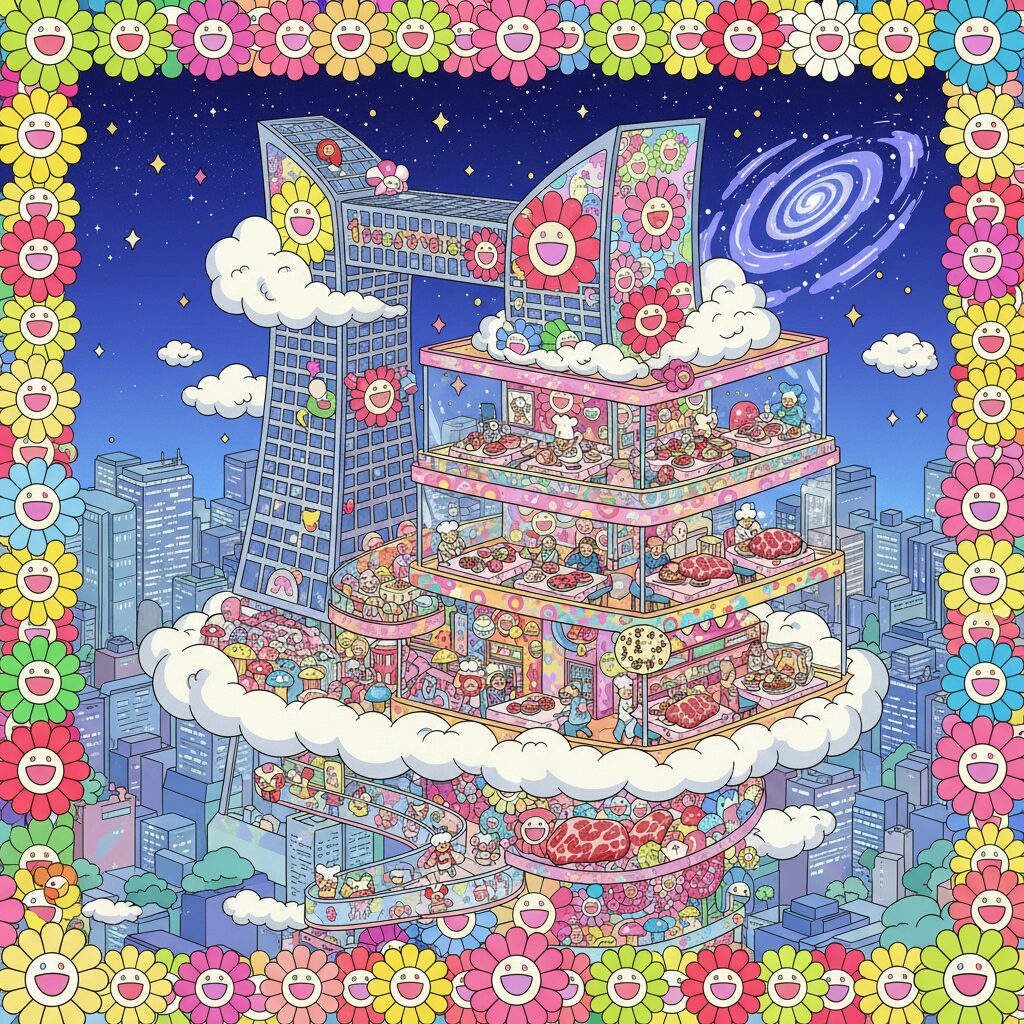
Choosing a restaurant in the Umeda sky is about crafting an entire evening. Each venue offers a distinct take on the luxurious Wagyu experience, a unique ambiance, and a special perspective on the shimmering cityscape. It’s not about picking the “best” spot, but the one that aligns with the memory you wish to create. The options are dazzling, often situated on the upper floors of luxury hotels or in the sleek, modern towers that shape the Umeda skyline, such as Grand Front Osaka or Hilton Plaza.
The Teppanyaki Theater: A Display of Fire and Flavor
Picture this: you are seated at a polished counter, the teppan—a large iron griddle—shining before you. Beyond the glass window, Osaka stretches out like a carpet of diamonds. The chef, impeccably dressed, bows slightly before starting. This is Teppanyaki, a form of culinary theater. The experience is intimate and thrilling. You are not merely a diner; you are an audience to a masterclass in precision and control.
The chef presents the uncooked Wagyu, a slab of beef so marbled it resembles a piece of intricate pink-and-white granite. They share its origin, perhaps from a farm in Kobe or Matsusaka. Then the show begins. The sharp, rhythmic tap of knives against the steel grill, the sizzle as the perfectly portioned steak meets the hot surface, the burst of controlled flame when sake or brandy is used to deglaze the grill. The aroma filling the air is intoxicating—the rich scent of searing beef, caramelized fat, and garlic crisped to golden perfection. The chef moves with the grace of a dancer, precise and economical. They may engage you in conversation, explaining their technique, or work silently, letting their craft speak. The Wagyu is cooked to your preference, often served in small, bite-sized pieces to be savored at their peak temperature. Eating teppanyaki Wagyu means tasting the beef in one of its purest forms, its extraordinary flavor sealed by intense, direct heat—a perfect contrast to the vibrant energy of the city below.
The Modern Kaiseki: Wagyu as a Star within a Culinary Constellation
For a different experience, one that honors the deeper traditions of Japanese cuisine, seek a restaurant featuring Wagyu within a modern kaiseki menu. Kaiseki is Japan’s haute cuisine, a multi-course meal that highlights seasonality, balance, and artistry. Here, Wagyu is not the sole focus but the stunning climax of a carefully choreographed culinary journey.
The ambiance in such a place is often one of serene, understated elegance. Think minimalist décor, natural materials, and an atmosphere of quiet reflection, all designed to draw your focus to the food and the view. Your evening might start with a delicate appetizer, a sakizuke, showcasing seasonal vegetables and seafood, artistically arranged on handcrafted ceramics. This is followed by a clear, comforting soup, a suimono, and a platter of impeccably fresh sashimi. Each course is a small masterpiece, reflecting the season. Then comes the main event. The Wagyu could be prepared as sumibiyaki, grilled over special binchotan charcoal that adds subtle smokiness without overshadowing the beef’s natural flavor. Alternatively, it might be served as delicate shabu-shabu, where paper-thin slices of beef are briefly swished through simmering broth. Within a kaiseki meal, the richness of Wagyu is perfectly balanced by the lighter dishes before and after. It’s an experience that narrates the story of Japanese nature and culinary philosophy, with the sparkling city lights offering a beautifully modern finale.
The Private Steak Sanctuary: Old-World Elegance Above the Neon
There are also venues that evoke the spirit of a classic, world-class steakhouse, infused with a uniquely Japanese sensibility. These are often housed in the area’s five-star hotels, providing an atmosphere of plush, refined comfort. Picture sinking into a supple leather armchair, a heavy linen napkin on your lap, with a sommelier guiding you through a cellar of international wines and premium Japanese sakes expertly paired with your meal.
In these sanctuaries, Wagyu is approached with reverent simplicity. The emphasis is on the cut and the aging process. Menus may detail not only the region but also the specific farm of origin. Dry-aged Wagyu is sometimes offered, a process that intensifies flavor into something even more profound and complex. The steak is the undeniable star, often cooked in a high-temperature broiler or on a searing grill to create a perfect crust while keeping the inside tender and rare. The service is impeccable, anticipatory, and discreet—the hallmark of Japanese omotenashi, or wholehearted hospitality. This setting is ideal for grand celebrations, romantic evenings, or for purists who believe a steak of this caliber needs little more than a pinch of salt and a flawless sear to shine. The view from these elegant perches feels different too—more stately, reflective, a serene vantage point over the bustling world from a luxurious sanctuary.
Navigating Your Night of Indulgence: Practical Tips for a Flawless Evening
An evening of fine dining in Umeda is a special occasion, and a bit of preparation goes a long way in making sure everything is flawless. These restaurants rank among the most sought-after in Osaka, and while spontaneity can be charming in other travel circumstances, it is not advisable here.
First and foremost: reservations are absolutely essential. It’s no exaggeration to say that prime tables, particularly on weekends or holidays, are reserved weeks or even months ahead. For international visitors, the best way to secure a booking is often through your hotel’s concierge service. They can overcome language barriers and frequently have established connections with top restaurants. Alternatively, several online platforms like TableCheck, Pocket Concierge, and Ikyu, which cater to Japan’s high-end dining scene, offer English interfaces.
Next, keep the dress code in mind. While Japan usually has a relaxed vibe, these establishments maintain a higher standard. Aim for at least “smart casual.” For men, this means collared shirts, smart trousers, and closed-toe shoes; a jacket is often advisable. For women, appropriate options include a dress, a chic blouse with a skirt, or elegant trousers. Avoid shorts, t-shirts, athletic wear, and flip-flops. Dressing appropriately is not just a rule—it’s a gesture of respect for the chef, staff, and the ambiance they create. It also elevates your own experience, making the evening feel as special as it truly is.
Timing matters as well. For the most stunning experience, try to reserve your table just before sunset. This allows you to enjoy the city’s breathtaking transition. You’ll see the sky shift through shades of orange, pink, and purple, followed by the gradual illumination of city lights until the entire landscape beneath you sparkles like a constellation. It’s a nightly performance by nature and humanity, and you’ll have the best view.
Regarding the menu, there’s no need to feel intimidated. Many restaurants offer set courses or omakase (“I leave it up to you”), which can be the ideal choice for first-timers to experience the chef’s vision. This removes the guesswork and guarantees a well-balanced, thoughtfully curated meal. If you opt for à la carte, don’t hesitate to ask your server or sommelier for recommendations. Their expertise is part of the experience, and they will be happy to guide you toward the perfect cut, preparation, and beverage pairing—whether it’s a bold Bordeaux, a crisp Junmai Daiginjo sake, or a rare Japanese whisky.
An Unforgettable Osaka Memory Etched in Light and Flavor
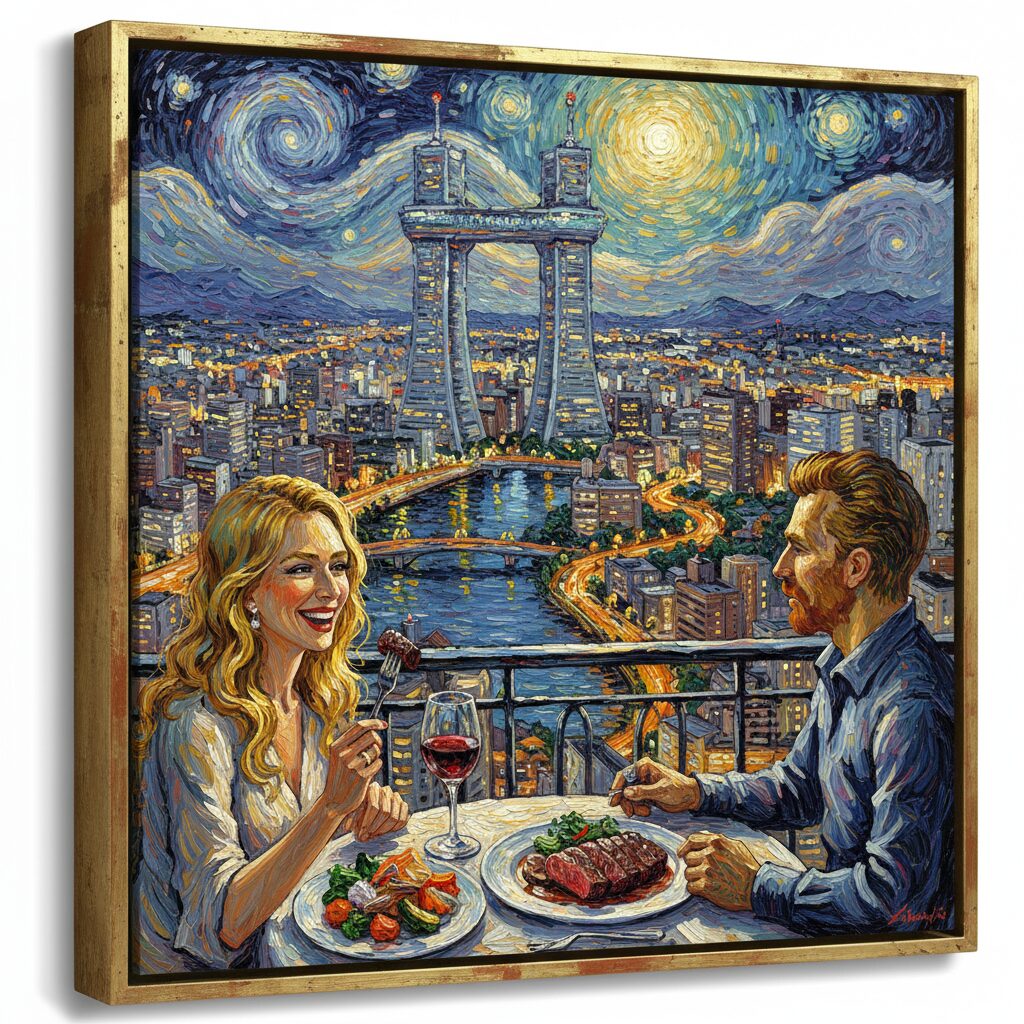
A meal like this is more than mere sustenance; it becomes a destination in itself. It’s a moment frozen in time, soaring above the vibrant, pulsating rhythm of Osaka. The memory will be a mosaic of sensations: the initial awe as you approach the window and see the city sprawled beneath you, the quiet sophistication of the dining room, the dramatic sizzle of the teppan, the first bite of Wagyu that hushes the table as it melts on your tongue, the intricate flavors of a perfectly matched drink, and the constant, captivating glow of the city’s lights.
This captures the true spirit of modern Osaka. It’s a city that reveres its rich culinary heritage with almost religious devotion while boldly embracing a futuristic vision. Dining on world-class Wagyu beneath the shadow of the Umeda Sky Building is where these two identities harmonize effortlessly. It’s an indulgence, a celebration, and a deeply cultural experience all at once. It’s a story you’ll carry with you—a sensory snapshot of a night spent in the dazzling heart of one of Japan’s most dynamic cities. So, come, reserve your table in the sky, and prepare to have your idea of a meal completely and spectacularly transformed.
